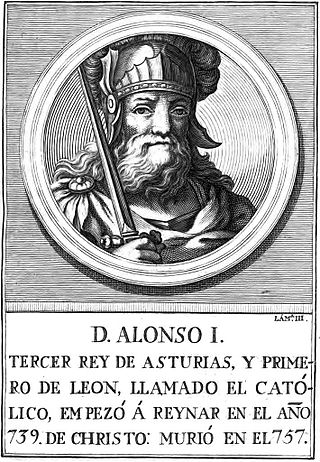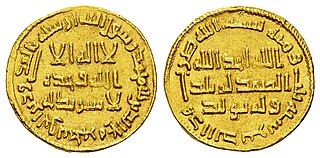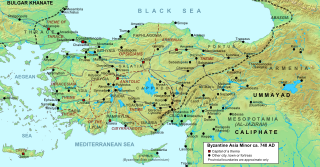
Leo III the Isaurian, also known as the Syrian, was the first Byzantine emperor of the Isaurian dynasty from 717 until his death in 741. He put an end to the Twenty Years' Anarchy, a period of great instability in the Byzantine Empire between 695 and 717, marked by the rapid succession of several emperors to the throne, along with ending the continual defeats and territorial losses the Byzantines had suffered during the 7th century. He also successfully defended the Empire against the invading Umayyads and forbade the veneration of icons.

The 8th century is the period from 701 through 800 (DCCC) in accordance with the Julian Calendar.
The 820s decade ran from January 1, 820, to December 31, 829.
The 740s decade ran from January 1, 740, to December 31, 749.
The 730s decade ran from January 1, 730, to December 31, 739.
The 720s decade ran from January 1, 720, to December 31, 729.
The 710s decade ran from January 1, 710, to December 31, 719.
The 700s decade ran from January 1, 700, to December 31, 709.

Year 742 (DCCXLII) was a common year starting on Monday of the Julian calendar, the 742nd year of the Common Era (CE) and Anno Domini (AD) designations, the 742nd year of the 1st millennium, the 42nd year of the 8th century, and the 3rd year of the 740s decade. The denomination 742 for this year has been used since the early medieval period, when the Anno Domini calendar era became the prevalent method in Europe for naming years.

Year 740 (DCCXL) was a leap year starting on Friday of the Julian calendar, the 740th year of the Common Era (CE) and Anno Domini (AD) designations, the 740th year of the 1st millennium, the 40th year of the 8th century, and the 1st year of the 740s decade. The denomination 740 for this year has been used since the early medieval period, when the Anno Domini calendar era became the prevalent method in Europe for naming years.

Year 724 (DCCXXIV) was a leap year starting on Saturday of the Julian calendar, the 724th year of the Common Era (CE) and Anno Domini (AD)

Year 717 (DCCXVII) was a common year starting on Friday of the Julian calendar. The denomination 717 for this year has been used since the early medieval period, when the Anno Domini calendar era became the prevalent method in Europe for naming years.

Year 733 (DCCXXXIII) was a common year starting on Thursday of the Julian calendar. The denomination 733 for this year has been used since the early medieval period, when the Anno Domini calendar era became the prevalent method in Europe for naming years.

Yazid ibn Abd al-Malik ibn Marwan, commonly known as Yazid II, was the ninth Umayyad caliph, ruling from 720 until his death in 724. Although he lacked administrative or military experience, he derived prestige from his lineage, being a descendant of both ruling branches of the Umayyad dynasty, the Sufyanids who founded the Umayyad Caliphate in 661 and the Marwanids who succeeded them in 684. He was designated by his half-brother, Caliph Sulayman ibn Abd al-Malik, as second-in-line to the succession after their cousin Umar, as a compromise with the sons of Abd al-Malik.
Hisham ibn Abd al-Malik ibn Marwan was the tenth Umayyad caliph, ruling from 724 until his death in 743.
Maslama ibn Abd al-Malik was an Umayyad prince and one of the most prominent Arab generals of the early decades of the 8th century, leading several campaigns against the Byzantine Empire and the Khazar Khaganate. He achieved great fame especially for leading the second and last Arab siege of the Byzantine capital Constantinople.

The Battle of Akroinon was fought at Akroinon or Akroinos in Phrygia, on the western edge of the Anatolian plateau, in 740 between an Umayyad Arab army and the Byzantine forces. The Arabs had been conducting regular raids into Anatolia for the past century, and the 740 expedition was the largest in recent decades, consisting of three separate divisions. One division, 20,000 strong under Abdallah al-Battal and al-Malik ibn Shu'aib, was confronted at Akroinon by the Byzantines under the command of Emperor Leo III the Isaurian and his son, the future Constantine V. The battle resulted in a decisive Byzantine victory. Coupled with the Umayyad Caliphate's troubles on other fronts and the internal instability before and after the Abbasid Revolt, this put an end to major Arab incursions into Anatolia for three decades.

The Byzantine Empire was ruled by the Isaurian dynasty from 717 to 802. The Isaurian emperors were successful in defending and consolidating the empire against the caliphates after the onslaught of the early Muslim conquests, but were less successful in Europe, where they suffered setbacks against the Bulgars, had to give up the Exarchate of Ravenna, and lost influence over Italy and the papacy to the growing power of the Franks.

The siege of Nicaea of 727 was an unsuccessful attempt by the Umayyad Caliphate to capture the Byzantine city of Nicaea, the capital of the Opsician Theme. Ever since its failure to capture the Byzantine Empire's capital, Constantinople, in 717–718, the Caliphate had launched a series of raids into Byzantine Asia Minor. In 727, the Arab army, led by one of the Caliph's sons, penetrated deep into Asia Minor, sacked two Byzantine fortresses and in late July arrived before Nicaea. Despite constant attacks for 40 days, the city held firm and the Arabs withdrew and returned to the Caliphate. The successful repulsion of the attack was a major boost for Byzantine emperor Leo III the Isaurian's recently initiated campaign to abolish the veneration of icons in the Empire; Leo claimed it as evidence of divine favour for his policy. The siege of Nicaea marks also the high point of the Umayyad raids, as new threats and defeats on their far-flung frontiers decreased Umayyad strength elsewhere, while Byzantine power strengthened afterwards.
Mu'awiya ibn Hisham (Arabic: معاوية بن هشام, romanized: Muʿāwiya ibn Hishām; was an Arab general and prince, the son of the Umayyad Caliph Hisham ibn Abd al-Malik, who distinguished himself in the Arab–Byzantine Wars. His son, Abd al-Rahman ibn Mu'awiya, was the founder of the Emirate of Córdoba and the Umayyad line of al-Andalus.










